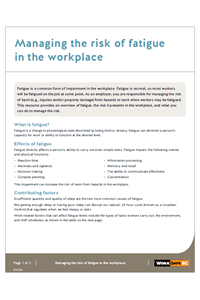Fatigue impairment
Fatigue — the state of feeling very tired or drowsy — is a common form of impairment in the workplace. When workers are fatigued, it can increase the risk of incidents and injuries to themselves, other workers, and members of the public.
Fatigue is a normal condition, and most workers will be fatigued at some time on the job. It is an employer’s responsibility to manage the risk of harm at work when workers are fatigued.
- Causes of fatigue
- Workplace effects of fatigue impairment
- Responsibilities
- Reducing the risk
- Resources
Causes of fatigue
The most common cause of fatigue is not getting enough sleep or having poor sleep quality. Fatigue can also be caused or intensified by factors related to the workplace task, the work environment, or scheduling, including factors such as the following:
- Repetitive or strenuous tasks
- Temperature
- Noise levels
- Light levels
- Vibration
- Night shifts or being awake between midnight and 6 a.m.
- Extended work hours or overtime
- Irregular shift rotation patterns
- Physically or mentally demanding work
Workplace effects of fatigue impairment
Fatigue reduces a person’s ability to work safely and effectively, and increases the risk of injury when workplace hazards are present.
Fatigue can influence us in many ways. Fatigue reduces:
- Alertness and vigilance
- Reaction time and the ability to react appropriately
- Memory and recall
- Ability to make effective and/or quick decisions
- Information processing
- Effective communication
Responsibilities
Both employers and workers have responsibilities for responding to fatigue in the workplace.
As a worker, you must tell your supervisor or employer if your ability to safely perform assigned work is impaired for any reason. This includes being impaired by fatigue.
As an employer, you must not assign impaired workers to activities where fatigue or other impairment may create an undue risk. You must also not allow workers to remain at the workplace while their ability to work safely is impaired by fatigue or another condition. In addition, as an employer you are responsible for managing health and safety risks in the workplace, including risks related to fatigue.
Reducing the risk
Consider the effects of fatigue in relation to your specific workplace processes and tasks, and evaluate the potential for harm when workers are fatigued. Managing risks associated with fatigue begins with these three steps:
- Identify workplace activities where being fatigued could increase the risk of harm
- Assess the level of risk associated with each of the identified hazards, how fatigue increases the risk of harm, and who may be affected
- Implement control measures to manage the risk
Examples of control measures include the following:
- Eliminate safety-critical work between the hours of midnight and 6 a.m.
- Design the work environment with good lighting, comfortable temperatures, and reasonable noise levels.
- Develop shift schedules and rotations that minimize the effects of fatigue.
- Provide education and training to workers about:
- Causes and consequences of fatigue
- Processes for reporting fatigue and other forms of impairment
- Workplace policies about fatigue and other forms of impairment
- Sleep hygiene practices and sleep disorder screening
For questions about managing fatigue risks in the workplace, contact Human Factors.

